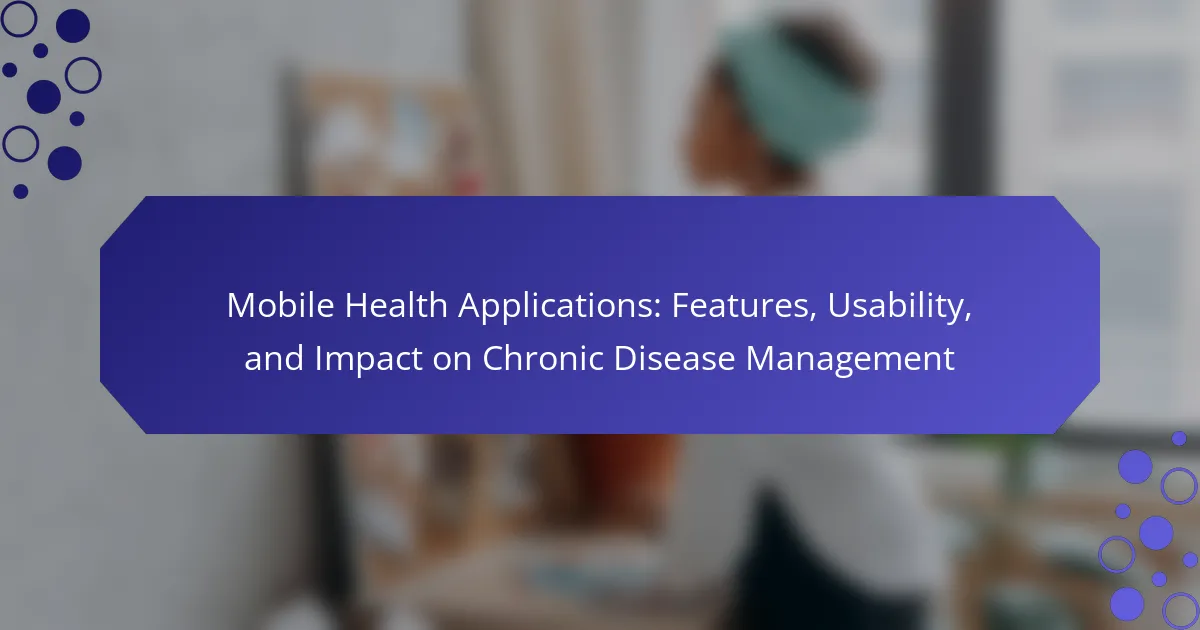Mobile health applications significantly improve chronic disease management by enhancing patient engagement and facilitating timely interventions. Key features include personalized health tracking, real-time monitoring, and integration with wearable devices. Usability challenges and cultural influences also impact their effectiveness. Understanding these aspects is crucial for optimizing outcomes in chronic disease care.
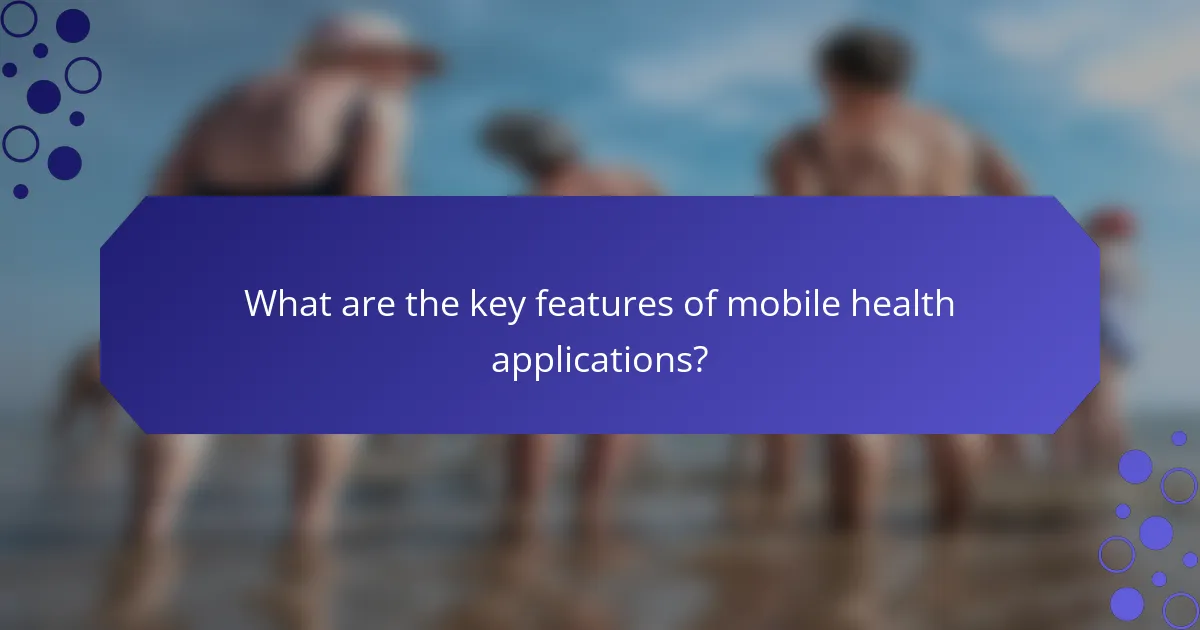
What are the key features of mobile health applications?
Mobile health applications feature user-friendly interfaces, personalized health tracking, real-time data sharing, and telemedicine capabilities. These features enhance chronic disease management by improving patient engagement and facilitating timely interventions. For instance, personalized health tracking can lead to better adherence to treatment plans. Additionally, the ability to share data with healthcare providers fosters collaborative care, which is vital for managing chronic conditions effectively.
How do user interfaces impact usability in health apps?
User interfaces significantly impact usability in health apps by enhancing user engagement and satisfaction. Intuitive design and clear navigation reduce frustration, leading to better health outcomes. For example, apps with user-friendly interfaces can increase adherence to chronic disease management protocols. Effective interfaces often incorporate visual cues and feedback mechanisms, improving the overall user experience.
Which data security measures are essential for mobile health applications?
Essential data security measures for mobile health applications include encryption, secure authentication, data access controls, and regular security updates. These measures protect sensitive health information and ensure compliance with regulations.
Encryption safeguards data during transmission and storage. Secure authentication, such as two-factor authentication, verifies user identities. Data access controls limit information access to authorized personnel only. Regular security updates address vulnerabilities and strengthen defenses against threats.
What role does user engagement play in app effectiveness?
User engagement significantly enhances app effectiveness by fostering adherence and improving health outcomes. Engaged users are more likely to utilize features consistently, leading to better management of chronic diseases. Increased interaction can manifest through personalized notifications, tracking progress, and community support, which collectively contribute to higher retention rates. Studies show that apps with high user engagement can lead to a 20% increase in positive health behaviour changes. Thus, prioritizing user engagement strategies is essential for maximizing the impact of mobile health applications.
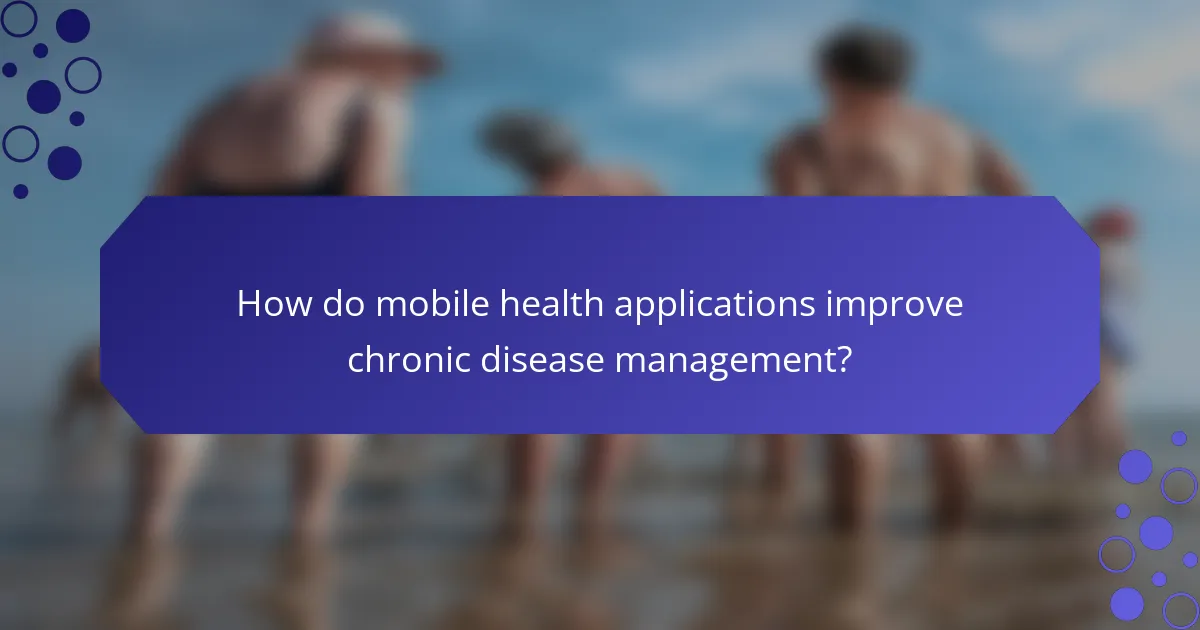
How do mobile health applications improve chronic disease management?
Mobile health applications enhance chronic disease management by providing real-time monitoring, personalized feedback, and improved communication with healthcare providers. These features empower patients to take control of their health, leading to better outcomes.
Applications often include symptom tracking, medication reminders, and educational resources, which help patients adhere to treatment plans. As a result, users experience increased engagement in their health management.
Data shows that patients using mobile health applications report higher satisfaction and improved health metrics. For example, a study found a 30% reduction in hospital readmissions among users.
The unique ability of these applications to integrate with wearable devices further enhances their effectiveness, allowing for continuous health monitoring and timely interventions.
What are the specific benefits for diabetes management through mobile apps?
Mobile apps provide several benefits for diabetes management, enhancing patient engagement and health outcomes. They enable users to track blood glucose levels, monitor dietary intake, and manage medication schedules effectively.
These applications often include features like reminders for medication, personalized feedback, and educational resources. As a result, users can make informed decisions, leading to better glycemic control.
Additionally, many apps offer data sharing capabilities with healthcare providers, facilitating timely interventions. This connectivity is crucial for adjusting treatment plans based on real-time data.
Overall, mobile health applications serve as powerful tools for managing diabetes, promoting adherence to treatment, and improving overall health.
How do mobile health apps facilitate medication adherence?
Mobile health apps enhance medication adherence through reminders, tracking, and education. These features empower patients to manage their medications effectively. For instance, apps can send notifications when it’s time to take a dose, reducing missed medications. Tracking features allow users to log their intake, which fosters accountability. Educational resources within the apps inform users about their medications, enhancing understanding and compliance. As a result, studies indicate that these applications can improve adherence rates significantly, contributing to better health outcomes in chronic disease management.
Which metrics are used to measure the impact of health apps on chronic disease outcomes?
Mobile health applications impact chronic disease outcomes through various metrics, including user engagement, clinical effectiveness, and patient-reported outcomes. Key metrics include adherence rates, symptom tracking, and quality of life assessments. These metrics provide insights into the apps’ effectiveness in managing chronic conditions. For example, adherence rates indicate how consistently users follow treatment plans via the app, while symptom tracking measures the app’s ability to monitor disease progression. Quality of life assessments evaluate how health apps influence overall well-being, emphasizing their role in chronic disease management.
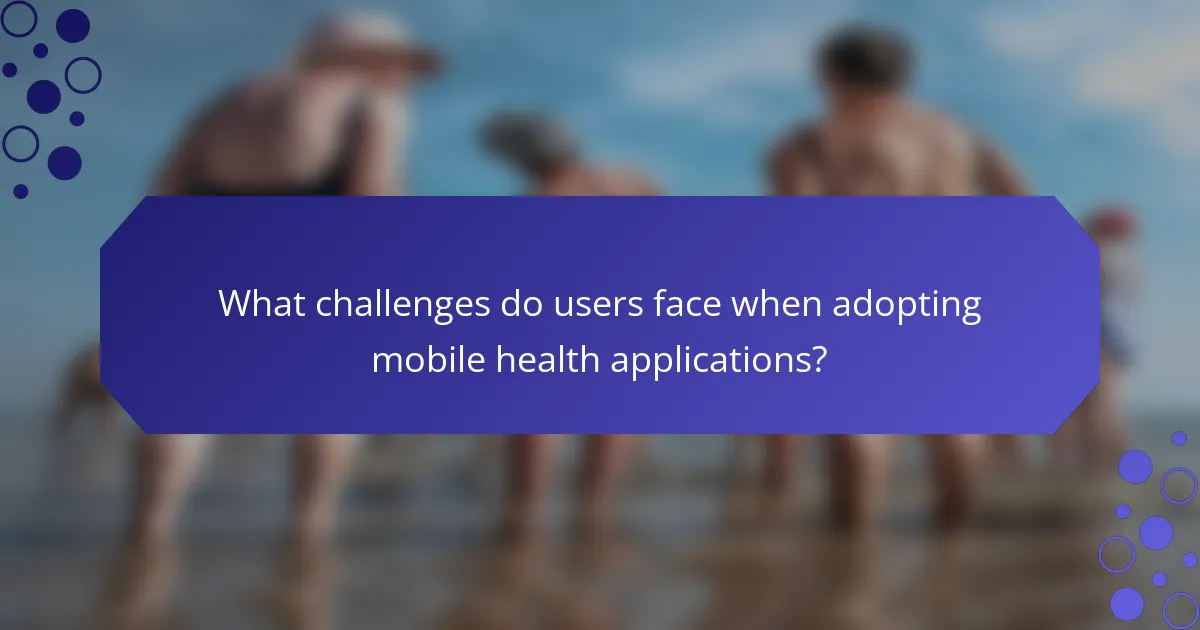
What challenges do users face when adopting mobile health applications?
Users face several challenges when adopting mobile health applications, including usability issues, data privacy concerns, and lack of integration with existing healthcare systems. Many apps have complex interfaces that hinder user engagement. Privacy concerns arise from sharing sensitive health data, leading to reluctance in usage. Additionally, integration with healthcare providers is often lacking, making it difficult for users to incorporate these applications into their overall health management. These obstacles can significantly impact the effectiveness of mobile health applications in chronic disease management.
How do technical issues affect user satisfaction and retention?
Technical issues significantly hinder user satisfaction and retention in mobile health applications. Users expect seamless functionality; any disruption can lead to frustration and disengagement.
For instance, slow loading times, crashes, or unresponsive features can result in negative experiences. A study found that 70% of users abandon apps due to poor performance.
Moreover, technical problems can undermine trust in the application’s ability to manage chronic diseases effectively. Users may perceive these issues as a lack of reliability, which is crucial in health management tools.
Addressing technical issues promptly enhances usability, ultimately improving user satisfaction and retention rates.
What are common misconceptions about mobile health applications?
Common misconceptions about mobile health applications include the belief that they replace healthcare providers, guarantee accurate health outcomes, and are only for tech-savvy users. Many users think these apps can diagnose conditions, but they primarily support management and monitoring. Additionally, some assume all apps are secure and reliable, overlooking the variability in quality and privacy practices. Lastly, there is a notion that mobile health applications are universally accessible, ignoring barriers like internet access and health literacy.
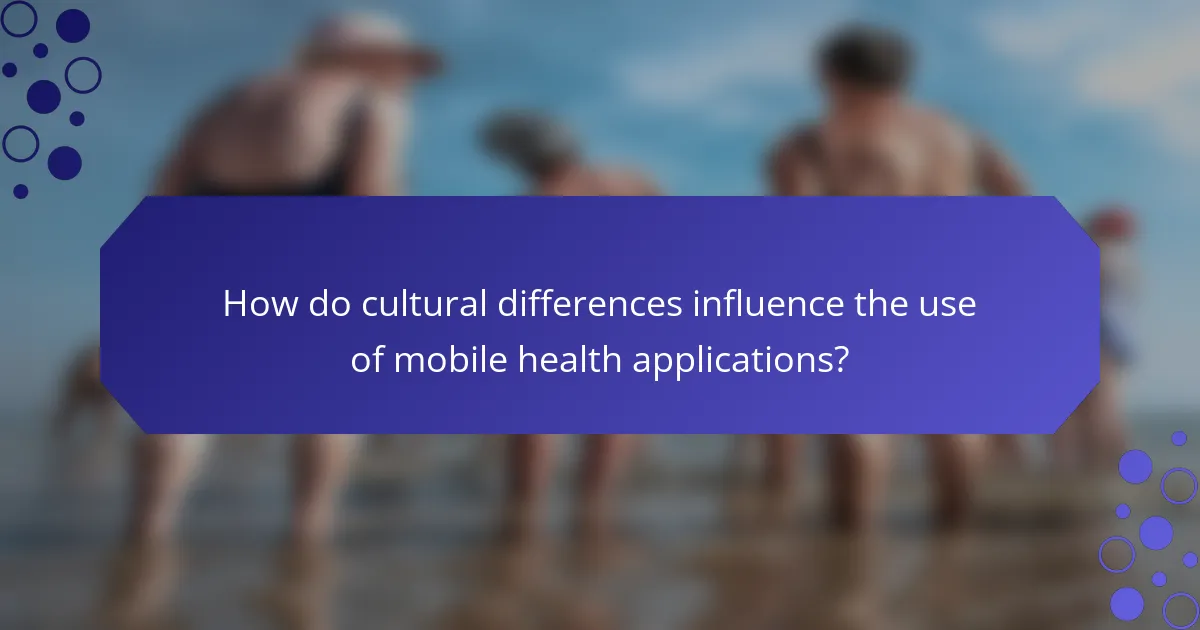
How do cultural differences influence the use of mobile health applications?
Cultural differences significantly influence the adoption and effectiveness of mobile health applications. These applications must align with local health beliefs, language preferences, and technology access to ensure usability and engagement.
For instance, in cultures with strong communal ties, features that promote social support and shared health goals may enhance user interaction. Conversely, in individualistic cultures, personalized health tracking and data privacy may be prioritized.
Moreover, cultural attitudes towards technology can affect the perceived credibility of mobile health applications. In some regions, skepticism towards digital health solutions may hinder their use, while in others, they may be embraced as innovative tools for health management.
Understanding these cultural nuances is essential for developers to create mobile health applications that resonate with diverse populations, ultimately improving chronic disease management outcomes.
Which features are prioritized in mobile health apps across different regions?
Mobile health applications prioritize features like user-friendly interfaces, personalized health tracking, and data security across different regions. These attributes enhance usability and improve chronic disease management.
| Feature | North America | Europe | Asia | Africa | Latin America |
|—————————–|—————|————–|————–|————–|—————-|
| User-friendly interface | High | Medium | High | Medium | High |
| Personalized health tracking | High | High | Medium | Low | Medium |
| Data security | High | High | Medium | Low | Medium |
| Integration with wearables | Medium | High | Low | Low | Medium |
| Telehealth capabilities | High | Medium | Medium | Low | Low |
| Community support features | Medium | Low | High | Medium | High |
How do user demographics affect the adoption of health apps?
User demographics significantly influence the adoption of health apps. Age, education, and tech-savviness impact user engagement and usability. Younger users tend to adopt mobile health applications more readily, while older adults may struggle with technology. Additionally, higher education levels correlate with increased app utilization, as educated users often seek innovative health solutions. Understanding these demographics helps developers tailor features to enhance user experience and improve chronic disease management outcomes.
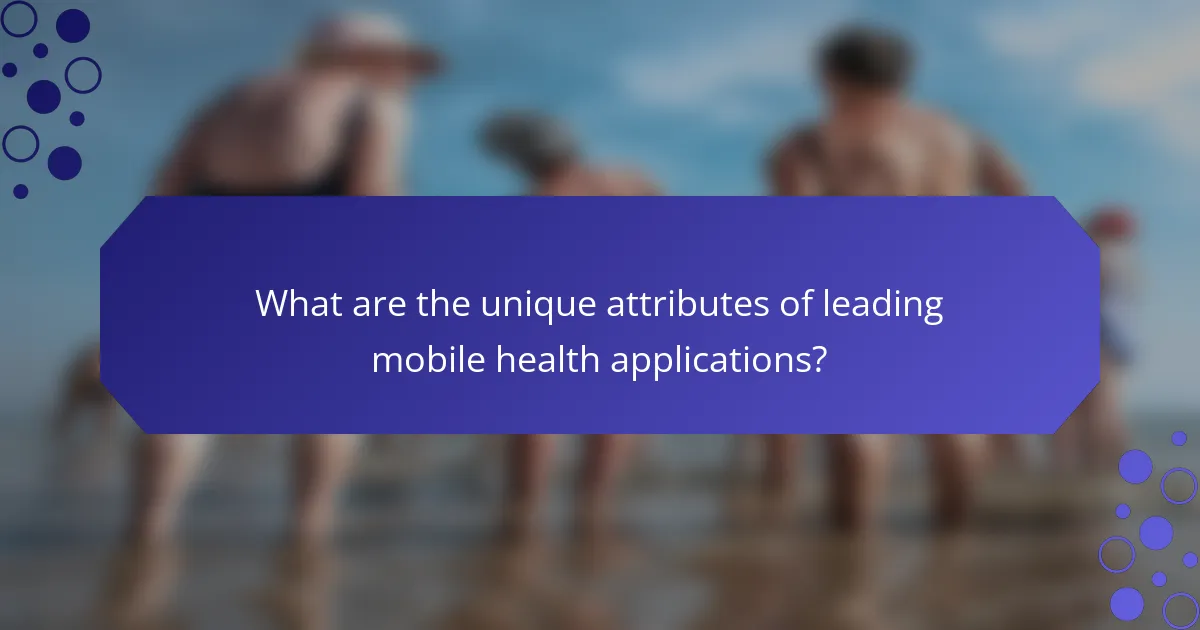
What are the unique attributes of leading mobile health applications?
Leading mobile health applications feature personalized user experiences, real-time health monitoring, and integration with wearable devices. These unique attributes enhance user engagement and improve chronic disease management outcomes. Personalization allows users to receive tailored recommendations, while real-time monitoring facilitates timely interventions. Integration with wearables provides seamless data collection, enhancing overall usability and effectiveness.
How do personalized health insights enhance user experience?
Personalized health insights significantly enhance user experience in mobile health applications. They provide tailored feedback, improving engagement and adherence to health plans.
These insights utilize user data to identify patterns and preferences, enabling customized recommendations. As a result, users receive relevant information, fostering a sense of ownership over their health management.
Furthermore, personalized insights can lead to better health outcomes by addressing individual needs. For instance, users with chronic conditions benefit from alerts about medication schedules or symptom tracking specific to their conditions.
Incorporating machine learning algorithms allows applications to continuously improve insights based on user interactions. This adaptability enhances the overall effectiveness of chronic disease management strategies.
What innovative technologies are integrated into top health apps?
Top health apps integrate innovative technologies like artificial intelligence, wearable device connectivity, and telehealth features. These technologies enhance user experience and improve chronic disease management. For example, AI algorithms analyze user data for personalized health recommendations. Wearable devices track vital signs, providing real-time health insights. Telehealth features enable remote consultations, increasing accessibility to healthcare professionals. These integrations significantly impact patient engagement and health outcomes.
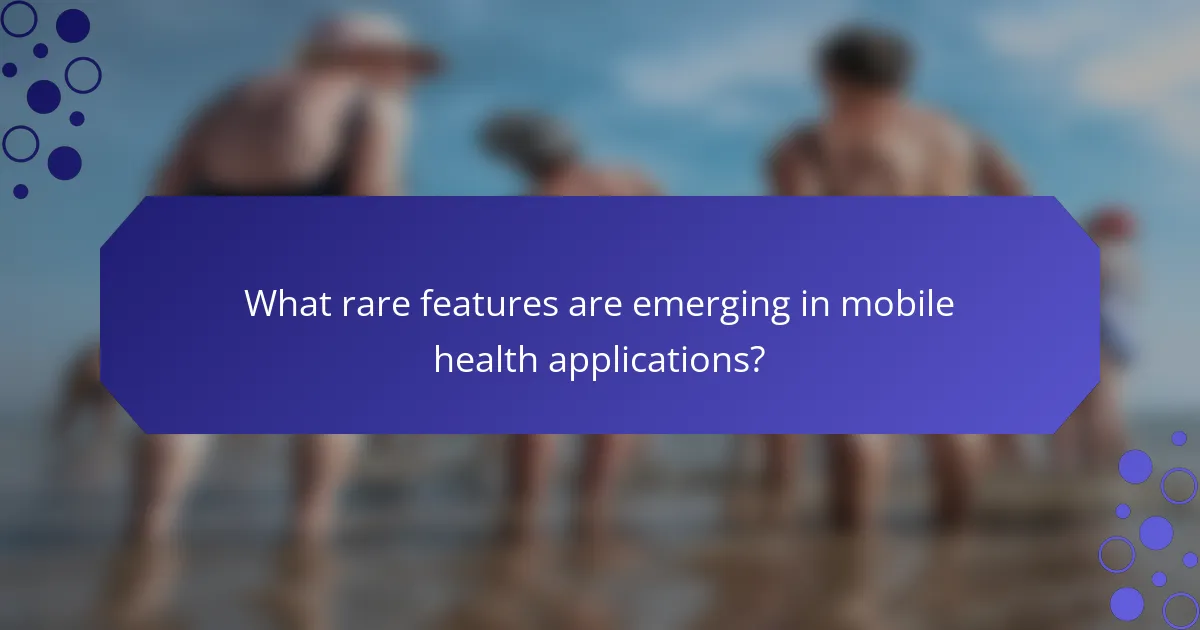
What rare features are emerging in mobile health applications?
Emerging rare features in mobile health applications include AI-driven personalized health insights, real-time biometric monitoring, and integration with wearable technology. These innovations enhance user engagement and improve chronic disease management. AI algorithms analyze user data to provide tailored recommendations, while wearable devices continuously track vital signs, offering a comprehensive view of health status.
How are artificial intelligence and machine learning shaping health app functionalities?
Artificial intelligence and machine learning enhance health app functionalities by personalizing user experiences and improving chronic disease management. These technologies analyze user data to provide tailored recommendations, monitor health metrics, and predict potential health issues. For instance, AI algorithms can identify patterns in patient behaviour, enabling proactive interventions. Additionally, machine learning enhances user engagement by adapting app interfaces based on individual preferences, ultimately leading to better health outcomes.
What unique partnerships are forming between health tech companies and healthcare providers?
Health tech companies are forming unique partnerships with healthcare providers to enhance chronic disease management through mobile health applications. These collaborations focus on integrating advanced features like real-time monitoring, personalized feedback, and data analytics.
For example, companies are leveraging telehealth functionalities to improve accessibility and patient engagement. These partnerships often involve shared data to refine treatment protocols and drive better health outcomes.
As a result, healthcare providers can utilize mobile applications to streamline communication, track patient progress, and adjust care plans effectively. This synergy fosters a more proactive approach to managing chronic diseases, ultimately benefiting patient care.
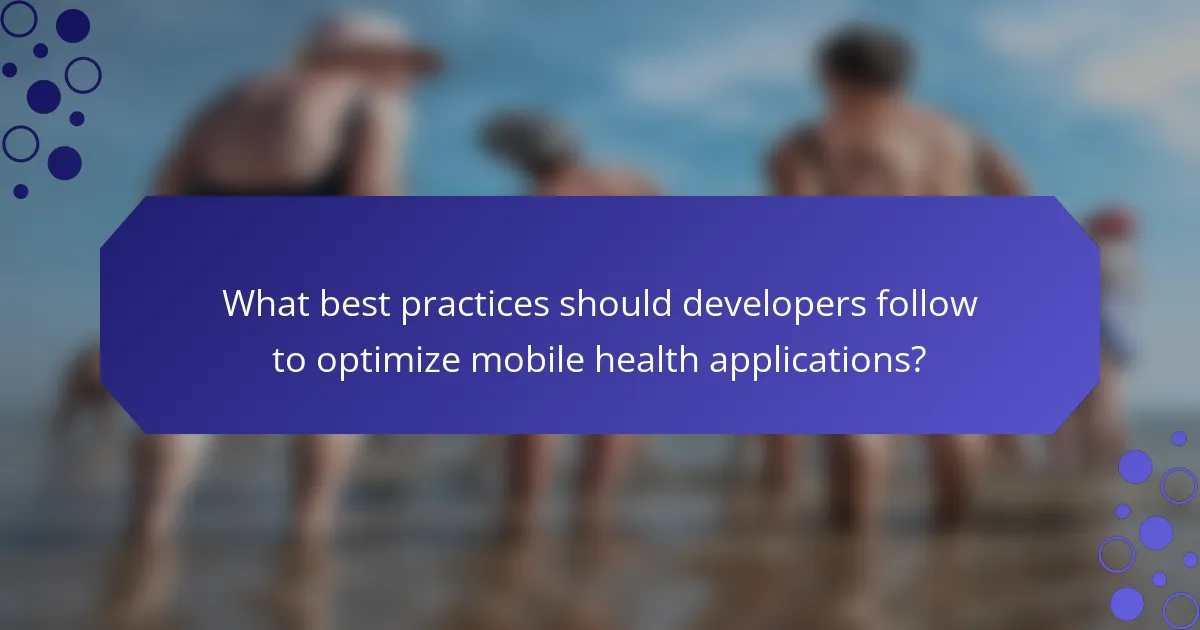
What best practices should developers follow to optimize mobile health applications?
Developers should follow best practices like user-centered design, ensuring data privacy, and minimizing cognitive load. Prioritize intuitive navigation and accessibility to enhance usability for chronic disease management. Integrate features like personalized reminders and health tracking to improve user engagement and outcomes. Regular updates based on user feedback can further optimize performance and relevance.
How can user feedback be effectively incorporated into app updates?
User feedback can be effectively incorporated into app updates by systematically analyzing and prioritizing user suggestions. First, gather feedback through surveys, reviews, and in-app prompts. Next, categorize feedback into themes such as usability, features, and performance. Prioritize these themes based on user impact and frequency of mention. Implement changes in iterative updates, testing each modification for user satisfaction. Finally, communicate updates to users, highlighting how their feedback shaped improvements. This approach enhances user engagement and fosters a responsive development culture.
What strategies enhance user retention and engagement in health apps?
User retention and engagement in health apps can be enhanced through personalized features, gamification, and user-friendly interfaces. Personalized reminders and tailored content increase user interaction. Gamification elements, like rewards for completing health tasks, motivate continued use. A seamless user interface ensures easy navigation, reducing drop-off rates. Regular updates and community features foster a sense of belonging, encouraging users to stay engaged.
